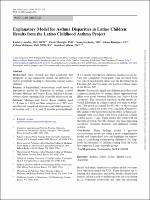Please use this identifier to cite or link to this item:
https://hdl.handle.net/20.500.12202/9823| Title: | Explanatory model for asthma disparities in Latino children: Results from the Latino Childhood Asthma Project |
| Authors: | Feldman, Jonathan Arcoleo, Kimberly Marsiglia, Flavio Serebrisky, Denise Rodriguez, Juliana McGovern, Colleen 0000-0002-7326-3026 |
| Keywords: | Asthma Child Latino Health status disparities |
| Issue Date: | 2020 |
| Publisher: | Taylor & Francis |
| Citation: | Arcoleo, K.J, Marsiglia, F.F, Serebrisky, D., Rodriguez, J., Soto, D., McGovern, C., & Feldman, J.M. (2020). Explanatory model for asthma disparities in Latino children: Results from the Latino Childhood Asthma Project. Annals of Behavioral Medicine, 54, 223-236. |
| Series/Report no.: | Annals of Behavioral Medicine;54 |
| Abstract: | Background: Little research has been conducted that integrates, in one explanatory model, the multitude of factors potentially leading to disparities among Latino children. Purpose: A longitudinal, observational study tested an explanatory model for disparities in asthma control between Mexican and Puerto Rican children with persistent asthma requiring daily controller medication use. Methods: Mexican and Puerto Rican children aged 5–12 years (n = 267) and their caregivers (n = 267) were enrolled and completed interviews and child spirometry at baseline and 3, 6, 9, and 12 months postenrollment. A 12 month retrospective children’s medical record review was completed. Participants were recruited from two school-based health clinics and the Breathmobile in Phoenix, AZ, and two inner-city hospital asthma clinics in the Bronx, NY. Results: Statistically significant differences in the social/ contextual predictors of asthma illness representations (IRs) were noted between Mexican and Puerto Rican caregivers. The structural equation model results revealed differences in asthma control over time by ethnicity. This model accounted for 40%-48% of the variance in asthma control test scores over 12 months. Caregivers’ IRs aligned with the professional model of asthma management were associated with better children’s asthma control across 1 year. These results also supported the theoretical notion that IRs change over time impacting caregivers’ treatment decisions and children’s asthma control. Conclusions: These findings extend a previous cross-sectional model test using a more comprehensive model and longitudinal data and highlight the importance of considering within-group differences for diagnosis and treatment of children coming from the vastly heterogeneous Latino umbrella group. Trial Registration: Trial number NCT 01099800 |
| Description: | Research article / Open access |
| URI: | https://www.researchgate.net/publication/336286913_Explanatory_Model_for_Asthma_Disparities_in_Latino_Children_Results_from_the_Latino_Childhood_Asthma_Project https://hdl.handle.net/20.500.12202/9823 |
| ISSN: | ISSN: 0277-0903, 1532-4303 |
| Appears in Collections: | Ferkauf Graduate School of Psychology: Faculty Publications |
Files in This Item:
| File | Description | Size | Format | |
|---|---|---|---|---|
| Feldman 2020 OA Explanatory_Model_for_Asthma_Disparities_in_Latino.pdf | 485.34 kB | Adobe PDF |  View/Open |
This item is licensed under a Creative Commons License

